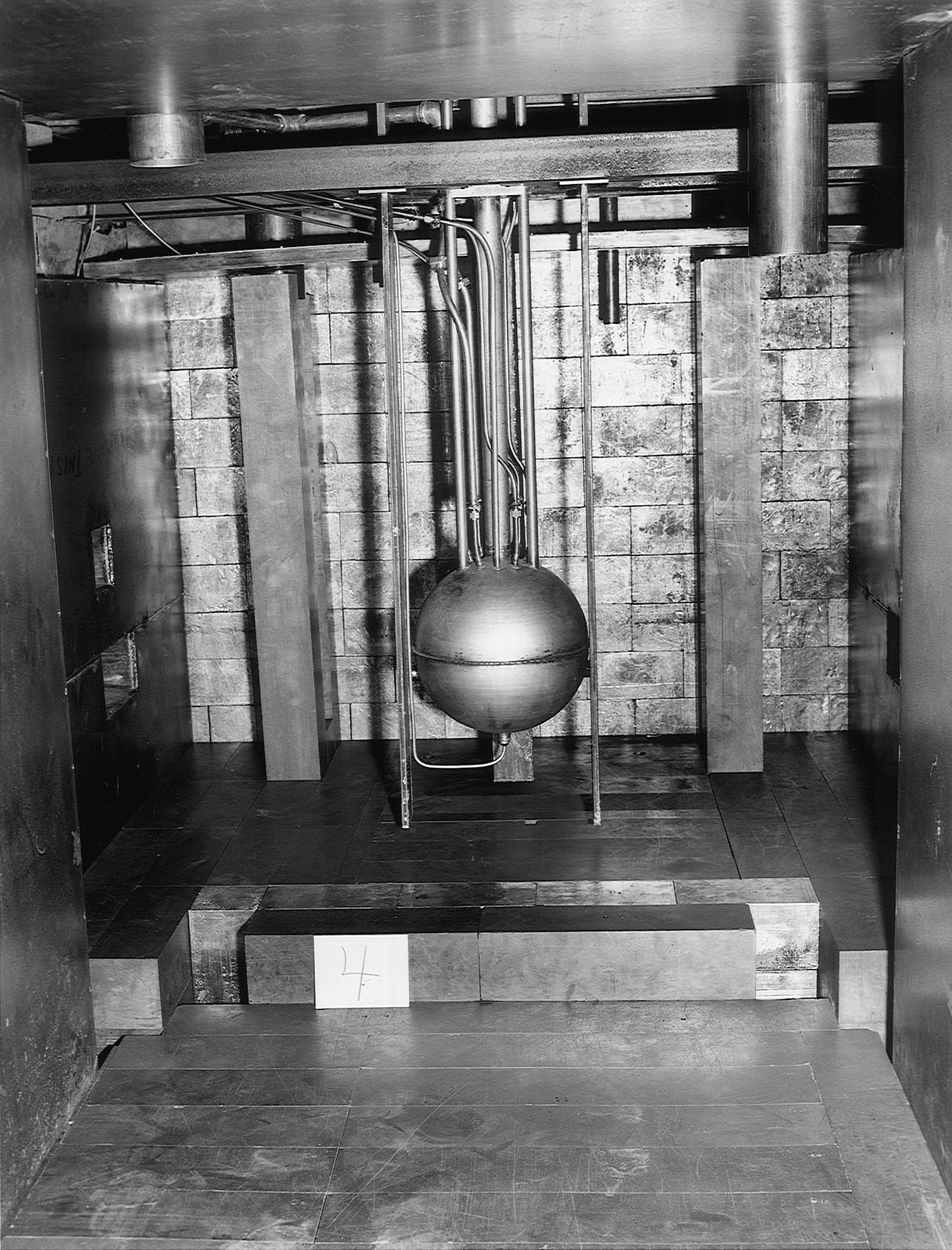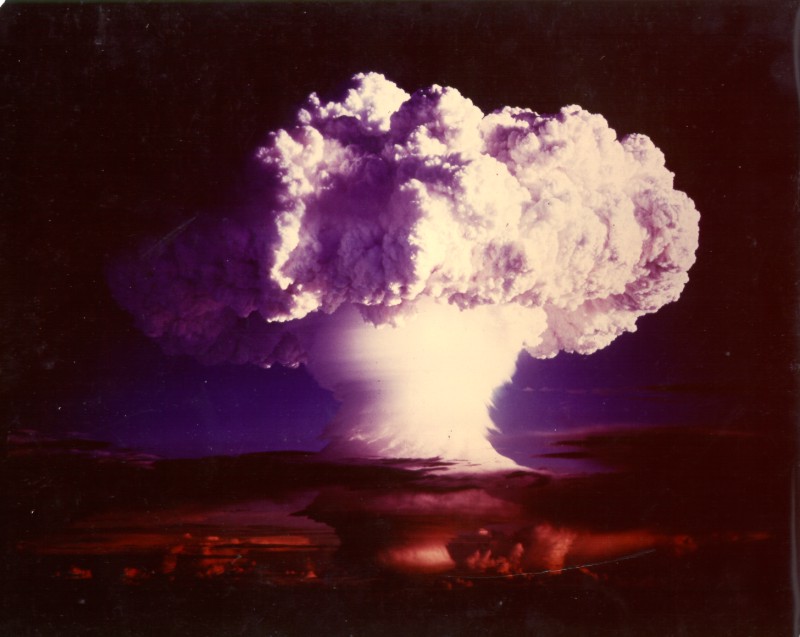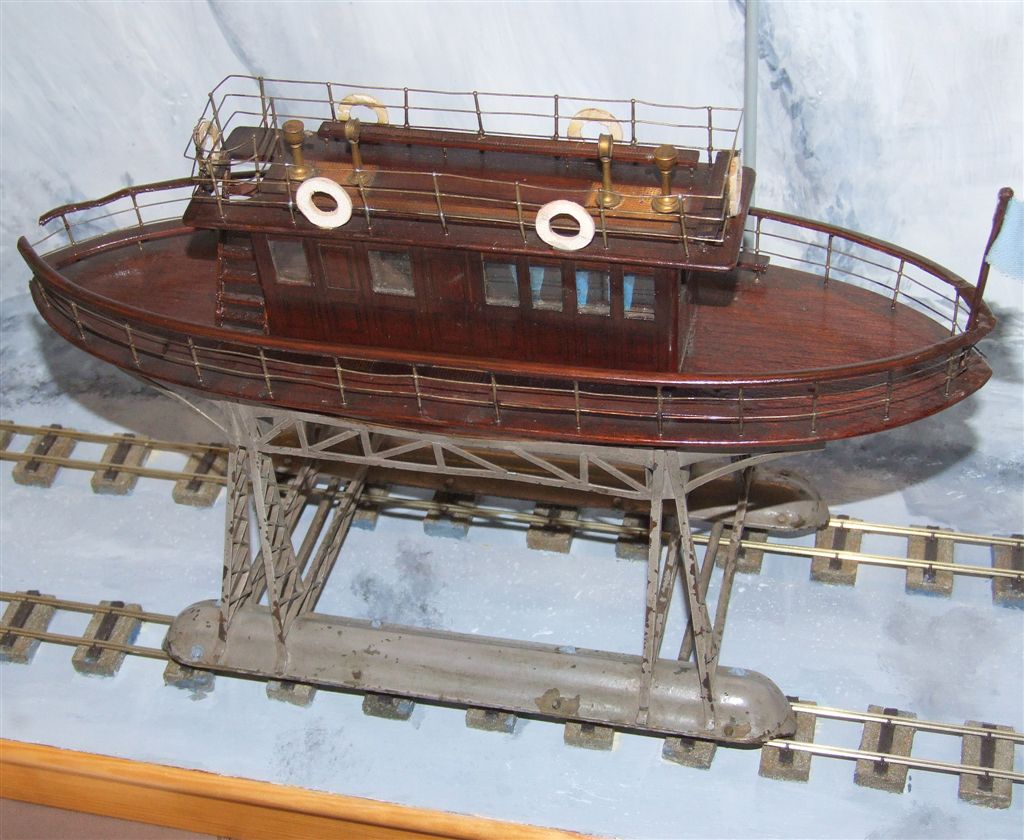|
Ivy Mike
Ivy Mike was the code name, codename given to the first full-scale test of a Thermonuclear weapon, thermonuclear device, in which a significant fraction of the explosive nuclear weapon yield, yield comes from nuclear fusion. Ivy Mike was detonated on November 1, 1952, by the United States on the island of Elugelab in Enewetak Atoll, in the now independent island nation of the Marshall Islands, as part of Operation Ivy. It was the first full test of the Teller–Ulam design, a Nuclear weapon design#Two-stage thermonuclear weapons, staged fusion device. Due to its physical size and fusion fuel type (cryogenic liquid deuterium), the "Mike" device was not suitable for use as a deliverable weapon. It was intended as a "technically conservative" proof of concept experiment to validate the concepts used for multi-TNT equivalent, megaton detonations. Samples from the explosion had traces of the isotopes plutonium-246, plutonium-244, and the predicted elements einsteinium and fermium. ... [...More Info...] [...Related Items...] OR: [Wikipedia] [Google] [Baidu] |
Mushroom Cloud
A mushroom cloud is a distinctive mushroom-shaped flammagenitus cloud of debris, smoke, and usually condensed water vapour resulting from a large explosion. The effect is most commonly associated with a nuclear explosion, but any sufficiently energetic detonation or deflagration will produce a similar effect. They can be caused by powerful conventional weapons, including thermobaric weapons such as the Father of All Bombs, ATBIP and GBU-43/B MOAB. Some Eruption column, volcanic eruptions and impact events can produce natural mushroom clouds. Mushroom clouds result from the sudden formation of a large volume of lower-density gases at any altitude, causing a Rayleigh–Taylor instability. The buoyant mass of gas rises rapidly, resulting in turbulent vortices curling downward around its edges, forming a temporary vortex ring that draws up a central column, possibly with smoke, debris, condensed water vapor, or a combination of these, to form the "mushroom stem". The mass of gas plu ... [...More Info...] [...Related Items...] OR: [Wikipedia] [Google] [Baidu] |
Teller–Ulam Design
A thermonuclear weapon, fusion weapon or hydrogen bomb (H-bomb) is a second-generation nuclear weapon design. Its greater sophistication affords it vastly greater destructive power than first-generation nuclear bombs, a more compact size, a lower mass, or a combination of these benefits. Characteristics of nuclear fusion reactions make possible the use of non-fissile depleted uranium as the weapon's main fuel, thus allowing more efficient use of scarce fissile material. Its multi-stage design is distinct from the usage of fusion in simpler boosted fission weapons. The first full-scale thermonuclear test (Ivy Mike) was carried out by the United States in 1952, and the concept has since been employed by at least the five recognized nuclear-weapon states and UNSC permanent members: the United States, Russia, the United Kingdom, China, and France. The design of all thermonuclear weapons is believed to be the ''Teller–Ulam configuration'', in which a fission bomb primary stage's ... [...More Info...] [...Related Items...] OR: [Wikipedia] [Google] [Baidu] |
Gordon Dean (lawyer)
Gordon Evans Dean (December 28, 1905 – August 15, 1958) was a Seattle-born"A friendly favor" ''Time'' magazine, Jul. 24, 1950. Retrieved 2-7-09. American lawyer and prosecutor who served as chairman of the United States Atomic Energy Commission (AEC) from 1950 to 1953. Early years Dean received his J.D. from the University of Southern California in 1930 and an LL.M. from Duke University Law School in 1932. In 1934, Dean joined the U.S. Department of Justice during the New Deal administration of President Franklin Delano Roosevelt. Dean served under Attorneys General Homer S. Cummings and Frank Murphy as a Criminal Division attorney and press spokesperson. He had taught at Duke Law before being hired as assistant to Brien McMahon in the Criminal Di ...[...More Info...] [...Related Items...] OR: [Wikipedia] [Google] [Baidu] |
United States Atomic Energy Commission
The United States Atomic Energy Commission (AEC) was an agency of the United States government established after World War II by the U.S. Congress to foster and control the peacetime development of atomic science and technology. President Harry S. Truman signed the McMahon/Atomic Energy Act on August 1, 1946, transferring the control of atomic energy from military to civilian hands, effective on January 1, 1947. This shift gave the members of the AEC complete control of the plants, laboratories, equipment, and personnel assembled during the war to produce the atomic bomb. An increasing number of critics during the 1960s charged that the AEC's regulations were insufficiently rigorous in several important areas, including radiation protection standards, nuclear reactor safety, plant siting, and environmental protection. By 1974, the AEC's regulatory programs had come under such strong attack that the U.S. Congress decided to abolish the AEC. The AEC was abolished by the Energ ... [...More Info...] [...Related Items...] OR: [Wikipedia] [Google] [Baidu] |
Marshall Holloway
Marshall Glecker Holloway (November 23, 1912 – June 18, 1991) was an American physicist who worked at the Los Alamos Laboratory during and after World War II. He was its representative, and the deputy scientific director, at the Operation Crossroads nuclear tests at Bikini Atoll in the Pacific in July 1946. Holloway became the head of the Laboratory's W Division, responsible for new weapons development. In September 1952 he was charged with designing, building and testing a thermonuclear weapon, popularly known as a hydrogen bomb. This culminated in the Ivy Mike test in November of that year. Early life Marshall Glecker Holloway was born in Oklahoma, on November 23, 1912, but his family moved to Florida when he was young. He graduated from Haines City High School, and entered the University of Florida, which awarded him a Bachelor of Science in education in 1933, and a Master of Science degree in physics in 1935. He went on to Cornell University, where he wrote his Doctor o ... [...More Info...] [...Related Items...] OR: [Wikipedia] [Google] [Baidu] |
Edward Teller
Edward Teller (; January 15, 1908 – September 9, 2003) was a Hungarian and American Theoretical physics, theoretical physicist and chemical engineer who is known colloquially as "the father of the hydrogen bomb" and one of the creators of the History of the Teller–Ulam design, Teller–Ulam design based on Stanisław Ulam's design. He had a volatile personality, and was "driven by his megaton ambitions, had a Messiah complex, messianic complex, and displayed autocratic behavior." A thermonuclear design he devised was an Alarm Clock model bomb with a yield of 1000 MT (1 GT of TNT) and he proposed delivering it by boat or submarine. It would be capable of incinerating a continent. Born in Austria-Hungary in 1908, Teller emigrated to the US in the 1930s, one of the many so-called The Martians (scientists), "Martians", a group of Hungarian scientist émigrés. He made numerous contributions to Nuclear physics, nuclear and molecular physics, spectroscopy, and Surface science, ... [...More Info...] [...Related Items...] OR: [Wikipedia] [Google] [Baidu] |
History Of The Teller–Ulam Design
The Teller–Ulam design is a technical concept behind modern thermonuclear weapons, also known as Nuclear weapon design#Hydrogen bombs, hydrogen bombs. The design relies on the radiation implosion principle, using thermal X-rays released from a fission nuclear primary to compress and ignite nuclear fusion in a secondary. This is in contrast to the simpler design and usage of nuclear fusion in Boosted fission weapon, boosted fission weapons. The design is named for scientists Edward Teller and Stanisław Ulam, who originally devised the concept in January 1951 for the United States and nuclear weapons, United States nuclear weapons program, though their individual roles have been subsequently debated. The US Operation Greenhouse, Greenhouse George test in May 1951, the world's first artificial thermonuclear fusion, validated the radiation implosion principle. The US first tested the "true" Teller-Ulam design with the very high-yield Ivy Mike test in 1952. The design was independe ... [...More Info...] [...Related Items...] OR: [Wikipedia] [Google] [Baidu] |
Fermium
Fermium is a synthetic chemical element; it has symbol Fm and atomic number 100. It is an actinide and the heaviest element that can be formed by neutron bombardment of lighter elements, and hence the last element that can be prepared in macroscopic quantities, although pure fermium metal has not been prepared yet. A total of 20 isotopes are known, with 257Fm being the longest-lived with a half-life of 100.5 days. Fermium was discovered in the debris of the first hydrogen bomb explosion in 1952, and named after Enrico Fermi, one of the pioneers of nuclear physics. Its chemistry is typical for the late actinides, with a preponderance of the +3 oxidation state but also an accessible +2 oxidation state. Owing to the small amounts of produced fermium and all of its isotopes having relatively short half-lives, there are currently no uses for it outside basic scientific research. Discovery Fermium was first discovered in the fallout from the 'Ivy Mike' nuclear test (1 Nove ... [...More Info...] [...Related Items...] OR: [Wikipedia] [Google] [Baidu] |
Einsteinium
Einsteinium is a synthetic chemical element; it has symbol Es and atomic number 99 and is a member of the actinide series and the seventh transuranium element. Einsteinium was discovered as a component of the debris of the first hydrogen bomb explosion in 1952. Its most common isotope, einsteinium-253 (Es; half-life 20.47 days), is produced artificially from decay of californium-253 in a few dedicated high-power nuclear reactors with a total yield on the order of one milligram per year. The reactor synthesis is followed by a complex process of separating einsteinium-253 from other actinides and products of their decay. Other isotopes are synthesized in various laboratories, but in much smaller amounts, by bombarding heavy actinide elements with light ions. Due to the small amounts of einsteinium produced and the short half-life of its most common isotope, there are no practical applications for it except basic scientific research. In particular, einsteinium was used to synthesiz ... [...More Info...] [...Related Items...] OR: [Wikipedia] [Google] [Baidu] |
Plutonium-244
Plutonium-244 (Pu) is an isotope of plutonium that has a half-life of 81.3 million years. This is longer than any other isotope of plutonium and longer than any other known isotope of an element beyond bismuth, except for the three naturally abundant ones: uranium-235 (704 million years), uranium-238 (4.468 billion years), and thorium-232 (14.05 billion years). Given the half-life of Pu, an exceedingly small amount should still be present on Earth, making plutonium a likely but unproven candidate as the shortest-lived primordial element. Natural occurrence Accurate measurements, beginning in the early 1970s, appeared to detect primordial plutonium-244, making it the shortest-lived primordial nuclide. The amount of Pu in the pre-Solar nebula (4.57×10 years ago) was estimated as 0.8% the amount of U. As the age of the Earth is about 56 half-lives of Pu, the amount of Pu left should be very small; Hoffman et al. estimated its content in the rare-earth mineral bastnasite as & ... [...More Info...] [...Related Items...] OR: [Wikipedia] [Google] [Baidu] |
Plutonium-246
Plutonium (Pu) is an artificial element, except for trace quantities resulting from neutron capture by uranium, and thus a standard atomic weight cannot be given. Like all artificial elements, it has no stable isotopes. It was synthesized before being found in nature, with the first isotope synthesized being Pu in 1940. Twenty-two plutonium radioisotopes have been characterized. The most stable are Pu with a half-life of 81.3 million years; Pu with a half-life of 373,300 years; Pu with a half-life of 24,110 years; and Pu with a half-life of 6,560 years. This element also has eight meta states; all have half-lives of less than one second. The known isotopes of plutonium range from Pu to Pu. The primary decay modes before the most stable isotope, Pu, are spontaneous fission and alpha decay; the primary mode after is beta emission. The primary decay products before Pu are isotopes of uranium and neptunium (not considering fission products), and the primary decay products after are iso ... [...More Info...] [...Related Items...] OR: [Wikipedia] [Google] [Baidu] |
Proof Of Concept
A proof of concept (POC or PoC), also known as proof of principle, is an inchoate realization of a certain idea or method in order to demonstrate its feasibility or viability. A proof of concept is usually small and may or may not be complete, but aims to demonstrate in principle that the concept has practical potential without needing to fully develop it. A proof of value (PoV) is sometimes used along proof of concept, and differs by focusing more on demonstrating the potential customer use case and value, and is usually less in-depth than a proof of concept. Usage history The term has been in use since 1967. In a 1969 hearing of the Committee on Science and Astronautics, Subcommittee on Advanced Research and Technology, ''proof of concept'' was defined as following: One definition of the term "proof of concept" was by Bruce Carsten in the context of a "proof-of-concept prototype" in his magazine column "Carsten's Corner" (1989): The column also provided definitions fo ... [...More Info...] [...Related Items...] OR: [Wikipedia] [Google] [Baidu] |










